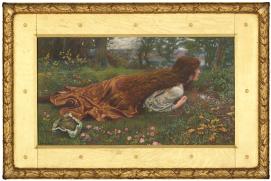“New Made of Flower Leaves”: Nature, Evolution and Female Education in Edward Robert Hughes’s The Princess out of School
Keywords:
Edward Hughes, The Princess out of SchoolAbstract
This essay is the first to explore the meaning and cultural context of Edward Robert Hughes’s large-scale watercolour The Princess out of School, 1901, in the collection of the National Gallery of Victoria. While the work has familiar artistic sources in depictions of reclining meditative figures, this lineage is combined with an unusually rich literary emphasis, referring to both Tennyson’s poem The Princess, 1847, in its title and Keats’ Endymion, 1818, in a quotation that accompanied the work when it was first exhibited.
Identified as a student by her abandoned scholar’s cap, Hughes’s figure takes up Tennyson’s narrative about a princess who founds a university exclusively for women, reflecting current debates about female education, untamed nature and Darwinian evolution. These ideas were also reflected in Gilbert and Sullivan’s Princess Ida, or Castle Adamant, first performed in 1884, with production designs that compare closely with Hughes’s composition. Hughes’s connections with leading aesthetic and literary circles are also reflected in the quotation from Keats’ poem referring to an idyllic bower that provides respite for his troubled protagonist Endymion. Likewise Hughes’s heroine rejects the academy in favour of a direct experience of nature, her robe and hair seemingly entwined with the flowers and leaves. Immersing her figure in a tapestry-like field of colours, Hughes extends his innovative use of watercolour towards the abstract metaphysical dimensions sought by Symbolist artists as well as writers such as Christina Rossetti, whose poetry he also illustrated. Audaciously emulating two of the most influential nineteenth-century poets, Hughes’s depiction is a therapeutic vision of nature: the fertile untamed bank which the princess studies ‘out of school’ reinterprets Keats’s visual aesthetic of organic plenitude while enacting Tennyson’s vision for female emancipation as part of a wider Darwinian evolution.
References
Barringer, Tim, Jason Rosenfeld and Alison Smith, eds. Pre-Raphaelites: Victorian Avant-Garde. London: Tate Britain, 2013.
“Beauty’s awakening, a masque of winter and of spring. Presented by members of the Art
Workers Guild.” The Studio, Summer Number, 1899.
Benson, Laurie. Medieval Moderns: The Pre-Raphaelite Brotherhood. Melbourne: National Gallery of Victoria, 2015.
Bond, Jessie. The Life and Reminiscences of Jessie Bond, the Old Savoyard as Told by Herself to Ethel Macgeorge. London: John Lane, The Bodley Head, 1930.
Bronkhurst, Judith. William Holman Hunt. A Catalogue Raisonné. New Haven: Yale U P, 2006.
Cooper, Robyn. “Arthur Hughes’s La Belle Dame Sans Merci and the Femme Fatale.” Art Bulletin of Victoria. Council of the National Gallery of Victoria, Melbourne, no. 27, 1986. https://www.ngv.vic.gov.au/essay/arthur-hughess-la-belle-dame-sans-merci-and-the-femme-fatale/
Cummings, Frederick. “Boothby, Rousseau and the Romantic Malady.” Burlington Magazine, 110.789 (Dec. 1968): 659-67.
Darwin, Charles. On the Origin of Species by Means of Natural Selection. London: John Murray, 1859, 1872 edition.
Davies, Emily. The Higher Education of Women. Ed. Janet Howarth. London: Hambledon, 1988.
Dearden, James S. John Ruskin: A Life in Pictures. Sheffield: Sheffield Academic, 1999.
Docherty, John. The Literary Products of the Lewis Carroll-George MacDonald Friendship. Lewiston: E. Mellen Press, c. 1995.
Donald, Diana, and Jane Munro, eds. Endless Forms. Charles Darwin, Natural Science and the Visual Arts, New Haven: Yale U P, 2009.
Fletcher, Pamela M. Narrating Modernity: the British Problem Picture 1895-1914. Aldershot: Ashgate, 2003.
Gibson, Robin. “Arthur Hughes: Arthurian and Related Subjects of the Early 1860s.” The Burlington Magazine, 112.808 (July 1970): 455-56.
Hunt, William Holman. Pre-Raphaelitism and the Pre-Raphaelite Brotherhood. 2 vols. London & New York: Macmillan, 1906.
Ingram, John. Flora Symbolica or, The Language and Sentiment of Flowers. London: Frederick Warne & Co., 1869.
Johnson, Rachel E. “The Tennyson Connection: Fragments from MacDonald’s Correspondence on Particular Occasions.” North Wind: A Journal of George MacDonald Studies, 3 (1984): 21-25. https://digitalcommons.snc.edu/northwind/vol3/iss1/3
Joseph, Gerhard. Tennyson and the Text: the Weaver’s Shuttle. Cambridge: Cambridge U P, 1992.
Killham, John. Tennyson and The Princess. London: Athlone, 1958. 5-6.
Kirkham, Victoria. “The First English Translator of Straparola, Masuccio, and Ser Giovanni: William George Waters in his Victorian World.” ARNOVIT (Archivio Novellistico Italiano), I (2016): 114-63.
Lago, Mary, ed. Burne-Jones Talking: His Conversations 1895-1898 Preserved by his Studio Assistant Thomas Rooke. London: John Murray, 1982.
Lovett, Charlie. Lewis Carroll Among His Books: A Descriptive Catalogue of the Private Library of Charles L. Dodgson. Jefferson, N.C.: McFarland, 2005.
Monckton Milnes, Richard. Life, Letters, and Literary Remains of Keats. London: Edward Moxon, 1848.
“Old Water Colours.” Literature, 185 (4 May 1901): 371.
Osborne, Victoria. “A British Symbolist in Pre-Raphaelite Circles: Edward Robert Hughes RWS (1851-1914).” M. Phil. thesis, University of Birmingham, 2009.
Parris, Leslie, ed. PreRaphaelite Papers. London: Tate Gallery, 1984.
Purton, Valerie, ed. Darwin, Tennyson and Their Readers: Explorations in Victorian Literature and Science. London: Anthem, 2013.
Roberts, Leonard. Arthur Hughes. His Life and Works. A Catalogue Raisonné. Suffolk: Antique Collectors’ Club, 1997.
Rossetti, Christina. “Amor Mundi.” Shilling Magazine, June 1865: 193.
Sloan, Kim, ed. Places of the Mind: British Watercolour Landscapes 1850-1950. London: Thames and Hudson, 2017.
Staley, Allen et al. The Post-Pre-Raphaelite Print: Etching, Illustration, Reproductive Engraving, and Photography in England in and around the 1860s. NY: Wallach Art Gallery, Columbia U, 1995.
Stott, Rebecca. “Tennyson’s Drift: Evolution in The Princess.” In Purton. 13-34.
Straparola, E. F. The Nights of Straparola, trans. W. G. Waters. 2 vols. London: Lawrence & Bullen, 1894.
Tennyson, Alfred. Idylls of the King, in Poems of Tennyson 1830-1870. London & NY: Oxford U P, 1912. 530-714.
——. The Princess, in Poems of Tennyson 1830-1870. London & NY: Oxford U P, 1912. 255-356.
The Gilbert and Sullivan Archive: https://www.gsarchive.net/
Tontiplaphol, Betsy Winakur. Poetics of Luxury in the Nineteenth Century: Keats, Tennyson, and Hopkins. Aldershot and Burlington, VT: Ashgate, 2011.
Warner, Malcolm. “John Everett Millais’s Autumn Leaves: ‘a picture full of beauty and without subject.’” In Parris. 126-42.
Wilde, Oscar. Poems. Boston: Robert Brothers, 1881.
Wood, Christopher. Burne-Jones. London: Weidenfeld & Nicolson, 1998.
Zimmerman, Virginia. Excavating Victorians. Albany NY: State U of New York P, 2008.

Downloads
Published
Versions
- 2022-10-21 (2)
- 2022-10-19 (1)

